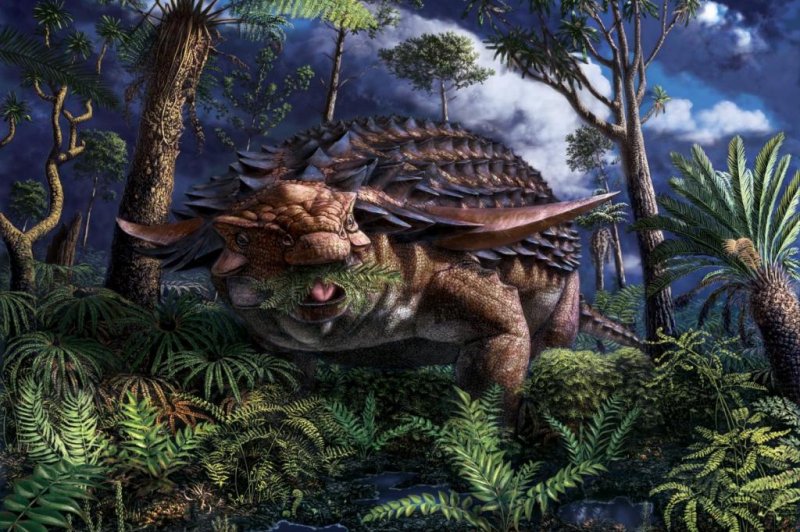While it's rare to find the fossilized stomach of a dinosaur, the stomach of one Borealopelta markmitchelli dinosaur revealed that its last meal was ferns. Illustration by Julius Csotonyi
June 2 (UPI) -- For the first time, scientists have recovered the remains of the last thing an herbivorous dinosaur ate. Researchers found the well-preserved stomach trapped inside the 110 million-year-old bones of a nodosaur, a kind of armored dinosaur called an ankylosaur.
Scientists have long speculated about the diets of dinosaurs, but concrete evidence has been hard to come by.
"Fossil stomach contents are quite rare. They are even rarer for herbivores," Caleb Brown, palaeontologist at the Royal Tyrrell Museum in Canada, told UPI in an email. "There have only been about nine reports of this for herbivorous dinosaurs, and only two or three of these are well-supported. Many of these other reports are just plants co-occurring with dinosaur skeletons."
But thanks to the poor luck of a single dinosaur, Borealopelta markmitchelli, researchers can definitively say that some dinosaurs ate plants, and that this particular dinosaur preferred ferns.
Researchers estimate that shortly after this particular nodosaur died, it was swept out to sea. As the dinosaur's thorny, armor-plated body sank into the seafloor sediment, the disturbed mud entombed it.
Though soft body tissue preservation in dinosaurs is still uncommon, scientists are getting better at finding the rarity -- in part, because scientists know where to look, including strata that has previously revealed soft tissue fossils.
"The preservation of soft tissues in fossils is a result of many factors, including rapid burial in fine sediments and lack of disturbance by scavengers," Brown said.
Finding the remnants of the last meals of carnivorous dinosaurs isn't uncommon, as bones are less fragile than plant material.
"The right conditions to preserve bone will preserve the bones of both the predator and the prey, whereas you may need different conditions to preserve both animal tissue and plant tissue," Brown said.
In the case of this sea-buried dinosaur, the conditions were right for the preservation of bone, stomach tissue and plant material.
Researches sliced the ancient contents of the dinosaur's stomach into extremely thin sections and examined them under powerful microscopes. Specific structures on the spores and leaves found in the slides helped researchers identify a variety of ferns that flourished during the Early Cretaceous.
The analysis of the ancient stomach contents -- detailed in a new study published Tuesday in the journal Royal Society Open Science -- allowed scientists to gain new insights into the ecology of Borealopelta markmitchelli.
The remnants of the dinosaur's last meal suggest the species was a picky eater. None of the most common plants were found in the it's stomach.
"It was selective in what it ate, eating some kinds of ferns and not others, and mostly ignoring the tough leaves of cycads and conifers, similar to animals today like deer which only eat the soft leaves of broadleaf trees and herbs," study co-author David Greenwood, biologist at Brandon University, told UPI in an email.
The stomach contents also contained stones, known as gizzard stones. Many herbivore past and present purposely consume bits of rock to aid digestion. Researchers also found bits of charcoal in the dinosaur's stomach.
"Many animals today self-medicate by eating charcoal, but we don't know why Borealopelta was eating charcoal," Greenwood said. "The charcoal though tells us this animal had been eating in an area that had experienced wildfire in the last 6 to 18 months, and was feeding on the lush and nutritious fern growth that grew after the fire."















